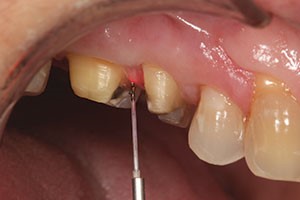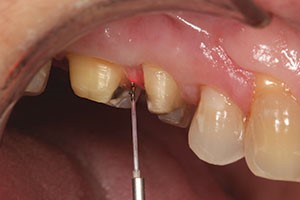
Laser diodes have been approved for use by the FDA for dental use for over 20 years, and have now become the most commonly used laser in dentistry. The most commonly used laser procedures in the dentistry are crown troughing, pocket disinfection, gingival contouring, and periodontal surgery. While all of these applications are widely used the single most commonly used laser procedure in dentistry is by far crown troughing, because of its ability to distend the tissue in a fraction of the time compared to traditional retraction techniques. And because of it’s ever growing popularity in this blog post we will dive into what exactly crown troughing is and what the laser requirements are for such an application.

Crown troughing is a method used by dentists for preparing the soft tissue around the base of the tooth, in order to enable the successful application and cementing of a crown. This process causes the soft tissue to be pulled back from the tooth at its base, and therefore allowing the cap to be pushed down just below the gumline ensuring a tight seal. Crown troughing was originally performed using a cord to wrap around the tooth to separate the soft tissue from the base, but this process can be rather time-consuming taking an average of five minutes per tooth. The next step in the evolution of crown troughing was to move to an electrosurgical approach, but this method can not be used in the presence of intraoral metals such as fillings or implants. Laser troughing by comparison offers the increased speed (typically 30 – 60 seconds) without the limitations associated with electrical interference. Diode laser crown troughing also has the added benefit of killing any bacteria in the cavity.
Near-infrared (around 800 nm) fiber coupled diode lasers are typically used in dentistry for crown troughing, where the fiber (usually 400-micron core diameter) is directed at the tooth soft tissue interface causing the tissue to pull back from the tooth. It is important that the laser power is selected so that enough energy is imparted to cause the tissue to pull back, but not so intense that the tissue burn. For this reason, most crown troughing lasers are limited to CW operation in the 600 mW to 800 mW range, or pulsed operation in the 1.2 w to 1.6 W power range.
LDX Optronics, specialists in high power diode lasers, offers a wide range of laser diodes which can be used in dental laser applications including laser crown troughing. Here at RPMC Lasers, we are excited to be the exclusive worldwide distributor LDX Optronics, we offer a wide range of laser packages which are ideal for integration into commercial laser dentistry systems.
To learn more about the diode lasers offered by LDX Optronics click here or talk to one of our laser experts today by emailing us at info@rpmclasers.com or click the button below!
Talk to a knowledgeable Product Manager today by emailing us at info@rpmclasers.com or by clicking the button below!
Have questions?
Additionally, www.dentalacademyofce.com is an excellent resource for developing a more detailed understanding of dental laser applications, if you would like to take a deeper dive into the subject you can take their online self-study course by clicking here.

 SHIPS TODAY
SHIPS TODAY 